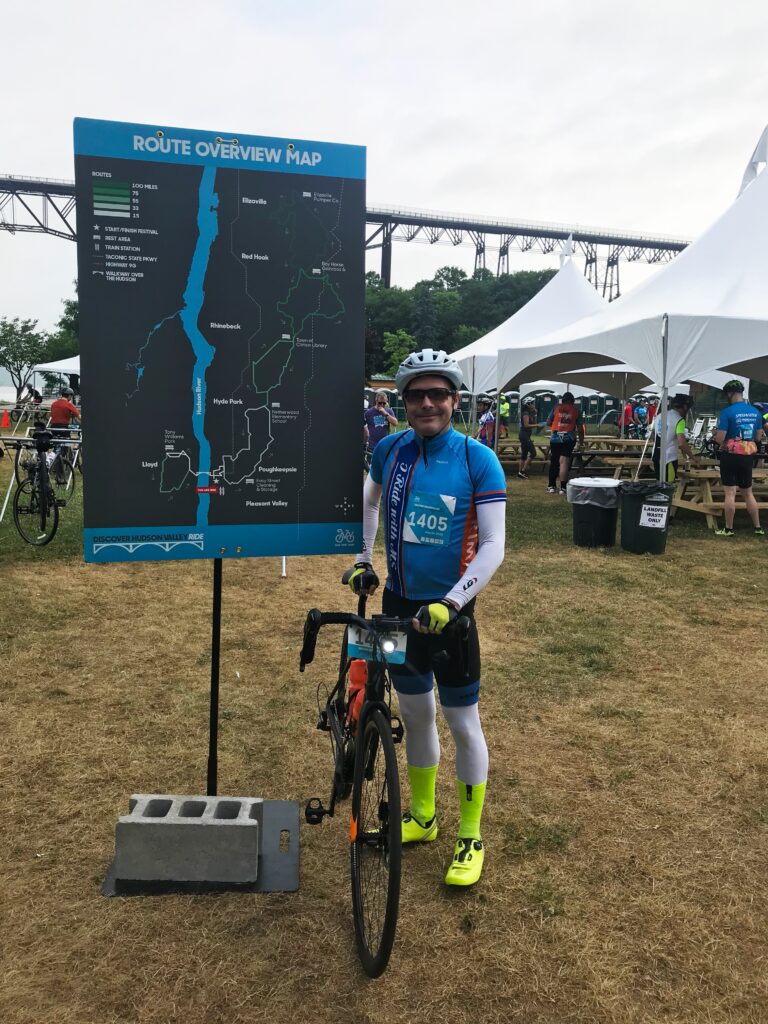Fall weather is perfect for bicycling, whether it’s a long-distance challenge or a leisurely family ride in the country. The sun is out, the air is crisp, the humidity tends to be lower — and the need for sun protection is as important as ever.
Cycling enthusiast Paul Melia (pictured above), knows a thing or two about sun protection. While he was growing up in Arlington, Virginia, his mom, a registered nurse, always put a T-shirt and sunscreen on her boy’s white Irish skin at the pool or the beach. Nevertheless, the freckles piled up.
He moved to New Jersey in 1993 and enjoyed cycling on the weekends, exploring the local sights. When he came to work for The Skin Cancer Foundation in 2008, he learned more about how skin damage accumulates over time, even from incidental exposure, and can lead to skin cancer.
When Paul had a major health scare that same year, it changed his life. “Since then, I’ve made long-distance cycling an integral part of my overall health plan,” he says. “I’m not interested in a treadmill that goes nowhere. I like having the freedom to determine where I go, when I go and how fast I go, while seeing new sights along the way.” He also knew that being outside on his bike for hours at a time would require a careful, and customized, approach to protect his high-risk lighter skin tone. Here are some important things he’s learned that can help other cyclists save their skin.
Paul’s Spin on Cycling Sun Safety
Target your protection. When you’re leaning over on a bike, Paul says, you get more sun exposure on the back of your neck, the back of your ears and the back of your legs. So while you should apply sunscreen to all exposed skin, pay special attention to those sometimes-neglected areas. He also wears a bike helmet with a visor to cast shade on his face, and UV protective sunglasses to protect his eyes.
 Choose clothing wisely. Much of the new biking gear available offers UPF protection, which stands for ultraviolet protection factor. The number indicates what fraction of the sun’s ultraviolet rays can penetrate the fabric. So a shirt with a UPF of 50, for example, allows just 1/50th of the sun’s UV radiation to reach your skin. Even better, Paul says, is that some of the high-tech UPF fabrics also wick away sweat and can help keep you warm or cool as needed. You can also find protective arm and leg sleeves, some in fluorescent colors to make you more visible.
Choose clothing wisely. Much of the new biking gear available offers UPF protection, which stands for ultraviolet protection factor. The number indicates what fraction of the sun’s ultraviolet rays can penetrate the fabric. So a shirt with a UPF of 50, for example, allows just 1/50th of the sun’s UV radiation to reach your skin. Even better, Paul says, is that some of the high-tech UPF fabrics also wick away sweat and can help keep you warm or cool as needed. You can also find protective arm and leg sleeves, some in fluorescent colors to make you more visible.
Practice the four “r’s.” “Many long-distance cyclists know and practice the three r’s of stopping every hour to rehydrate, refuel and repeat,” Paul says. The Skin Cancer Foundation advises everyone to reapply sunscreen every two hours — or more often if you’re sweating. “So for cyclists,” Paul says, “why not add another r when stopping each hour and reapply that sunscreen?”
His measure of success? When he comes into the office on Monday and his coworkers ask if he rode over the weekend, because they don’t see any change in that vulnerable Irish skin.





